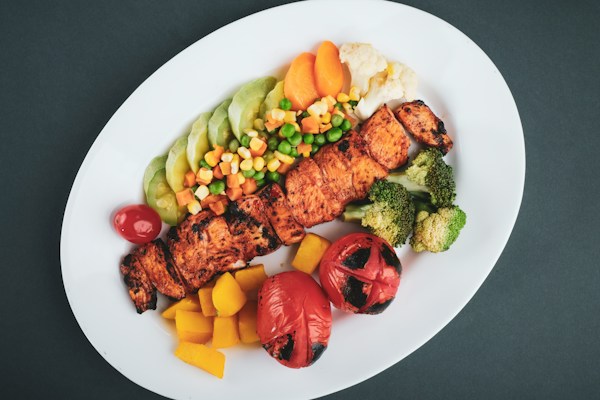Managing Blood Sugar Levels Through Diet: Top 10 Food Categories and Recipes
In a world where dietary choices are endless and often overwhelming, understanding how to manage blood sugar levels through diet is crucial, especially for those with concerns about diabetes, pre-diabetes, or general health maintenance. Food is not just a source of pleasure and nourishment; it also plays a pivotal role in regulating our body’s most vital functions, including the management of blood sugar levels.
This article is designed as a guide to help you navigate the realm of healthy eating specifically tailored to blood sugar control. Whether you’re looking to revamp your diet, manage a medical condition, or simply maintain optimal health, understanding the impact of what you eat on your blood sugar is key.
We will explore the top 10 food categories that are not only delicious but are also beneficial in maintaining healthy blood sugar levels. Each category is accompanied by suggested recipes, making it easier for you to incorporate these foods into your daily diet.
Let’s embark on this journey of healthful eating, where each meal brings you closer to balanced and controlled blood sugar levels.
1. High-Fiber Vegetables
Fiber-rich vegetables are great for stabilizing blood sugar levels due to their low glycemic index and high nutrient content.
Suggested Recipe: Try a Kale and Swiss Chard Salad for a nutrient-packed meal.
2. Lean Proteins
Lean proteins are essential for a balanced diet and help in blood sugar management by slowing digestion and preventing blood sugar spikes.
Suggested Recipe: A simple Grilled Lemon Herb Chicken Breast can be a staple in your diet.
3. Whole Grains
Whole grains are a healthier alternative to refined grains, as they have a lower glycemic index and are high in fiber.
Suggested Recipe: Quinoa Pilaf is an excellent choice for a healthy, hearty side.
4. Legumes & Beans
Legumes and beans are excellent sources of plant-based protein and fiber, aiding in blood sugar regulation.
Suggested Recipe: Enjoy a delicious Black Bean Soup for a filling meal.
5. Healthy Fats
Healthy fats, such as those found in avocados, nuts, and olive oil, can help manage blood sugar by slowing the absorption of carbohydrates.
Suggested Recipe: An Avocado and Walnut Salad makes a great lunch option.
6. Low-Glycemic Fruits
Fruits like berries, apples, and citrus are lower on the glycemic index and provide essential vitamins and fiber.
Suggested Recipe: A Mixed Berry Salad is a refreshing and healthy dessert.
7. Dairy & Dairy Alternatives
Low-fat dairy and dairy alternatives can be good sources of protein and calcium without significantly impacting blood sugar levels.
Suggested Recipe: Try a Greek Yogurt Parfait with nuts and berries for breakfast.
8. Soups & Broths
Soups, especially those rich in vegetables and lean proteins, can be fulfilling without causing blood sugar spikes.
Suggested Recipe: A Chicken and Vegetable Soup is both comforting and healthy.
9. Salads & Slaws
Salads and slaws with a variety of vegetables and a source of protein can be a balanced meal for blood sugar management.
Suggested Recipe: Enjoy a Cabbage and Carrot Slaw as a light side dish.
10. Snacks & Small Plates
Healthy snacks can help manage hunger and prevent overeating during meals, which is important for blood sugar control.
Suggested Recipe: Almond Butter and Banana Open Sandwich is a quick and satisfying snack.
Importance of Diet in Blood Sugar Management
Diet plays a key role in managing blood sugar levels. Foods with a low glycemic index, such as most vegetables and whole grains, cause a slower, more gradual rise in blood sugar, as opposed to high-glycemic foods like white bread and sugary snacks. Including a variety of foods from these categories ensures a balanced intake of carbohydrates, protein, and fats, which is crucial for stabilizing blood sugar levels.
Tips for Meal Planning
When planning meals, consider the following tips:
- Balance Your Plate: Aim for a balance of proteins, carbohydrates, and fats in each meal.
- Monitor Portion Sizes: Be mindful of portion sizes to avoid overeating.
- Stay Hydrated: Drink plenty of water throughout the day.
- Snack Wisely: Choose snacks that are low in sugar and high in protein or healthy fats.
Conclusion
As we reach the end of our culinary journey through the top 10 food categories for blood sugar control, it’s clear that managing blood sugar levels goes beyond just monitoring glucose readings. It’s about embracing a lifestyle that incorporates balanced, nutritious, and delicious food choices. The power to positively impact your health lies significantly in what you put on your plate.
The recipes and food categories we’ve explored offer a roadmap to a diet that not only helps in managing blood sugar levels but also contributes to overall well-being. From the fiber-rich goodness of vegetables to the satisfying proteins and wholesome grains, each category is a piece in the puzzle of a balanced diet. Remember, these food choices are not just for those with blood sugar concerns but are beneficial for anyone seeking a healthier lifestyle.
As you integrate these foods and recipes into your daily routine, remember that consistency is key. Small, sustainable changes in your diet can lead to significant improvements in your health over time. So, whether you’re experimenting with a new vegetable soup recipe or tossing up a fresh berry salad, know that each meal is a step towards better health.
In conclusion, let’s celebrate the diversity of nutritious foods available to us and the joy of preparing and consuming meals that not only taste good but also nurture our bodies. Here’s to your health and happiness, one plate at a time! 🥗🍲🍓
P.S. For more information check out my other article 2024’s Key to Balanced Health: Understanding and Utilizing Sugar Transforming Enzymes


